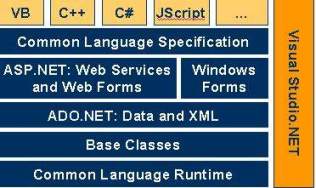ASP.NET Architecture
ASP.NET is based on the fundamental architecture of .NET Framework. Visual studio provide a uniform way to combine the various features of this Architecture.

Architecture is explained form bottom to top in the following discussion.
- At the bottom of the Architecture is Common Language Runtime. NET Framework common language runtime resides on top of the operating system services. The common language runtime loads and executes code that targets the runtime. This code is therefore called managed code. The runtime gives you, for example, the ability for cross-language integration.
- .NET Framework provides a rich set of class libraries. These include base classes, like networking and input/output classes, a data class library for data access, and classes for use by programming tools, such as debugging services. All of them are brought together by the Services Framework, which sits on top of the common language runtime.
- ADO.NET is Microsoft’s ActiveX Data Object (ADO) model for the .NET Framework. ADO.NET is not simply the migration of the popular ADO model to the managed environment but a completely new paradigm for data access and manipulation.
ADO.NET is intended specifically for developing web applications. This is evident from its two major design principles:- Disconnected Datasets—In ADO.NET, almost all data manipulation is done outside the context of an open database connection.
- Effortless Data Exchange with XML—Datasets can converse in the universal data format of the Web, namely XML.
- The 4th layer of the framework consists of the Windows application model and, in parallel, the Web application model.
The Web application model-in the slide presented as ASP.NET-includes Web Forms and Web Services.
ASP.NET comes with built-in Web Forms controls, which are responsible for generating the user interface. They mirror typical HTML widgets like text boxes or buttons. If these controls do not fit your needs, you are free to create your own user controls.
Web Services brings you a model to bind different applications over the Internet. This model is based on existing infrastructure and applications and is therefore standard-based, simple, and adaptable.
Web Services are software solutions delivered via Internet to any device. Today, that means Web browsers on computers, for the most part, but the device-agnostic design of .NET will eliminate this limitation. - One of the obvious themes of .NET is unification and interoperability between various programming languages. In order to achieve this; certain rules must be laid and all the languages must follow these rules. In other words we can not have languages running around creating their own extensions and their own fancy new data types. CLS is the collection of the rules and constraints that every language (that seeks to achieve .NET compatibility) must follow.
- The CLR and the .NET Frameworks in general, however, are designed in such a way that code written in one language can not only seamlessly be used by another language. Hence ASP.NET can be programmed in any of the .NET compatible language whether it is VB.NET, C#, Managed C++ or JScript.NET.
Resource: codeproject
No comments:
Post a Comment